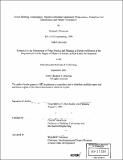| dc.contributor.advisor | Leon R. Glicksman. | en_US |
| dc.contributor.author | Donovan, Richard J. (Richard James), 1974- | en_US |
| dc.contributor.other | Massachusetts Institute of Technology. Dept. of Urban Studies and Planning. | en_US |
| dc.date.accessioned | 2005-08-23T18:43:16Z | |
| dc.date.available | 2005-08-23T18:43:16Z | |
| dc.date.copyright | 2001 | en_US |
| dc.date.issued | 2001 | en_US |
| dc.identifier.uri | http://hdl.handle.net/1721.1/8262 | |
| dc.description | Thesis (S.M.)--Massachusetts Institute of Technology, Dept. of Urban Studies and Planning, 2001. | en_US |
| dc.description | Includes bibliographical references (p. 61-64). | en_US |
| dc.description.abstract | This thesis explores implications of green, or environmentally sensitive, development in the commercial real estate industry. Developers, as building owners, will respond to ideas that can improve their profits, not necessarily to an environmental call to arms. The ability to lease up a development quickly is a competitive advantage that a developer can realize as increased net operating income. Green building strategies may increase the productivity of occupants, which may also help a developer differentiate a project from the competition. Three green building technologies, underfloor air distribution, photovoltaics, and natural ventilation, are examined in detail to determine if they are financially feasible for a developer to include in a commercial real estate office project. This thesis attempts to use a financial argument, to address the issue of environmental sustainable, or green, development. The results of the study are that natural ventilation and underfloor air distribution are currently promising technologies that should be seriously considered by developers. The high cost of photovoltaics, however, does not justify their current use in a commercial development. A large part of the decision to include green developments is dependent on the developer understanding his/her clients, the tenants. This thesis includes a survey of both developers and tenants in an effort to gauge their interest in green technologies and willingness to pay for them. The results of the survey are presented, and suggestions for the future of green building practices are laid out. | en_US |
| dc.description.statementofresponsibility | by Richard J. Donovan. | en_US |
| dc.format.extent | 104 p. | en_US |
| dc.format.extent | 6377370 bytes | |
| dc.format.extent | 6377129 bytes | |
| dc.format.mimetype | application/pdf | |
| dc.format.mimetype | application/pdf | |
| dc.language.iso | eng | en_US |
| dc.publisher | Massachusetts Institute of Technology | en_US |
| dc.rights | M.I.T. theses are protected by copyright. They may be viewed from this source for any purpose, but reproduction or distribution in any format is prohibited without written permission. See provided URL for inquiries about permission. | en_US |
| dc.rights.uri | http://dspace.mit.edu/handle/1721.1/7582 | |
| dc.subject | Urban Studies and Planning. | en_US |
| dc.title | Green building technologies : should a developer implement photovoltaics, underfloor air distribution, and natural ventilation? | en_US |
| dc.type | Thesis | en_US |
| dc.description.degree | S.M. | en_US |
| dc.contributor.department | Massachusetts Institute of Technology. Department of Urban Studies and Planning | |
| dc.identifier.oclc | 50333513 | en_US |
